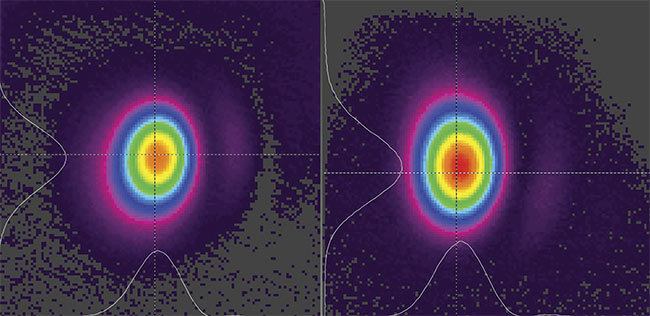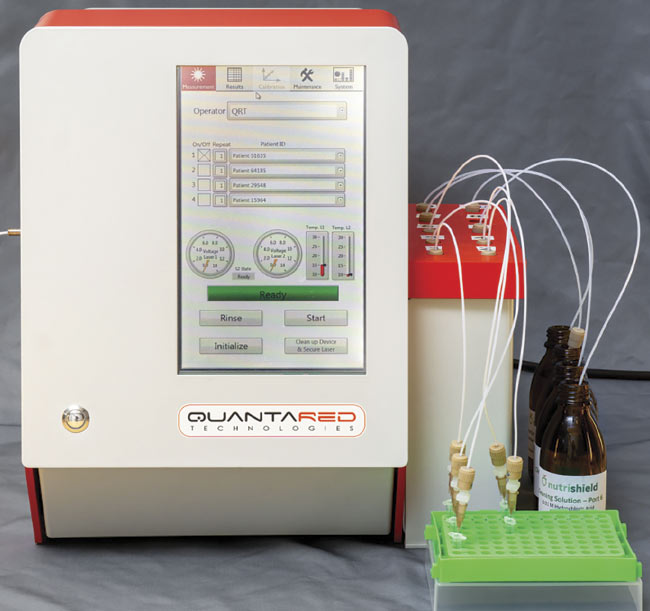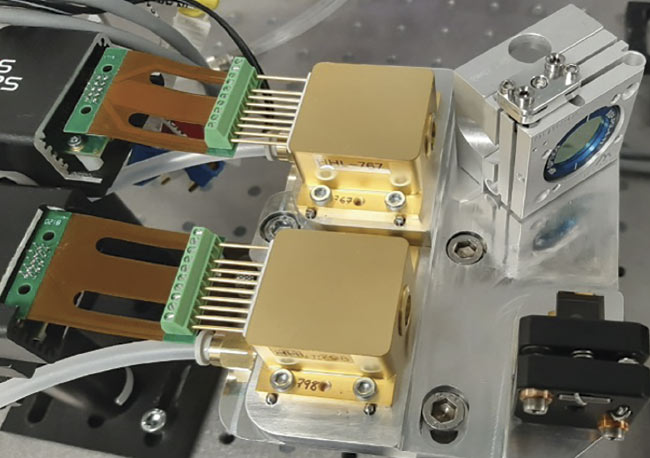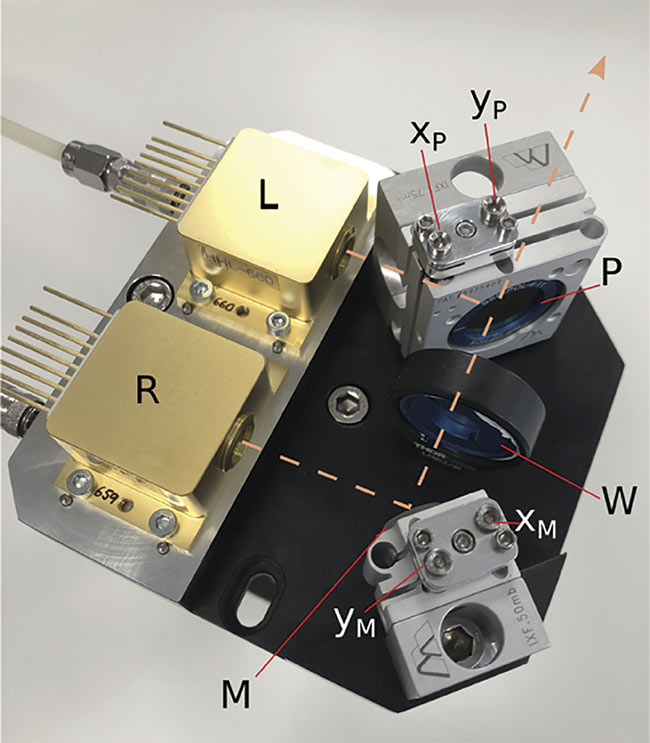
Quantum Cascade Lasers Boost Life Science Research
Mid-Infrared QCL imaging helps spectroscopists to analyze tissue sections and perform drug analysis. It also enables real-time, online glucose monitoring.
By Olivier Landry, Panagiotis Georgiadis, Alex Kenich, and Miltiadis Vasileiadis
In October 1971, Rudolf F. Kazarinov and Robert A. Suris proposed the “possibility of amplification of electromagnetic waves in a semiconductor with a superlattice”1. It took the scientific community over 20 years to build a device that made use of this principle. In 1994, Jérôme Faist and colleagues published the results of the first working prototype of a laser source based on intersubband transitions, the excited state in the conduction bands between quantum wells2. Faist later co-founded Alpes Lasers.

Typical beam profiles of a quantum cascade laser (QCL). Courtesy of Alpes Lasers.
Over 20 years have passed since the first quantum cascade laser (QCL) sources were commercialized. QCLs that operate at room temperature using thermoelectric cooling are now ubiquitous. These lasers ushered in a new era of infrared spectroscopy. In recent years, there have been many advancements in the stability, power, spectral range, tunability, and overall performance of QCLs. In addition, another type of mid-IR-emitting laser is the interband cascade laser (ICL). As with QCLs, each injected carrier in ICLs generates multiple photons. ICLs are based on type-II heterostructures and cascading interband transitions (transfers between electronic bands) instead of the intersubband transitions of QCLs. ICLs complement QCLs in lower wavelengths, while they typically outperform them in the <3.5 µm range.
Such developments in the infrared spectrum have led to the creation of a wide variety of very powerful light sources for spectroscopists. As a result, several new applications that make use of coherent mid-infrared light sources have been demonstrated in medicine and industry.
Much like how Fourier transform infrared (FTIR) spectroscopy devices superseded dispersive spectrometers in the early 1970s, QCLs are now replacing FTIR devices, leading to yet another paradigm shift.
Several key areas that have benefited immensely from research involving QCLs include biology, pathology, and toxicology in the life sciences industry, as well as the health care and pharmaceutical industries.
With their increased power (allowing penetration of thicker samples), and their ruggedness and compactness (allowing them to be deployed in clinical settings), QCLs are quickly becoming a go-to technology for conducting medical research.
Applications such as mid-infrared imaging of thin tissue sections, laser-based spectroscopy of liquid or gaseous samples, biomarker monitoring, pathogen detection, and drug development analysis are just a few examples of how mid-infrared lasers can be used in the life sciences and biomedical domains.
QCLs have enabled improvements in medical applications that range from lab analysis of samples to game-changing apps such as continuous noninvasive glucose monitoring. While there has been much progress, the biomedical community has yet to uncover the full potential of QCL technology.
Medical imaging
IR imaging has led to significant advancements in medical science. Multispectral and hyperspectral imaging technology have proved very effective for biomolecular studies and histopathology, and the use of imaging to facilitate medical intervention is becoming more important, in terms of both test timing and accuracy.
A wealth of noninvasive IR imaging techniques have been produced that make use of the infrared spectrum to analyze tissues and cells. A subset of these techniques constructs images using back-
reflected light (active). Other methods — in which IR detectors sense thermal emissions and produce a heat map of emission distribution in tissues — rely on detecting IR radiation emitted by the tissue as a result of its temperature (passive). In addition, the use of labeled imaging in IR3 is no longer an experimental technique, but now stands on its own as an established technology4.
The use of the infrared part of the electromagnetic spectrum enables a wide range of techniques in clinical diagnostics, ranging from high-resolution and depth-resolved visualization of tissue to temperature variation (thermographic) assessment. In addition, remarkable progress has been made toward mid-IR spectral in vitro mapping of tissue and cell classification — for example, for identifying cancerous cells5. However, significant potential is yet to be tapped in the use of mid-IR photonics for such analysis, especially for label-free cell and tissue classification6.
Most commercially available mid-IR imaging devices either have limited wavelength capabilities (that is, they use a single-mode laser source), or have low power, resulting in a lower signal-to-noise ratio (as in the case of FTIR microscopy). Each device is typically tailored to a specific medical imaging application and is therefore constructed to address a particular range in the mid-IR spectrum. QCL sources have a distinct advantage in this area: They can be tailored to specific purposes, or they can address multiple needs at once, as demonstrated by Andreas Schwaighofer and colleagues in a recent paper7.
Recent research initiatives seek to further extend QCL capabilities by developing mid-infrared imaging devices that combine the best of both worlds. Developers are hoping to provide both the spectral tunability of FTIR devices and the strong signal of laser sources that are based on multilaser external cavity configurations, combining up to six broad-gain lasers in an external cavity configuration. These devices provide unprecedented capabilities for laser sources in the mid-infrared, in terms of tunability, precision, and power.
Breath analysis
The science of analyzing exhaled air, also known as breathomics or exhalomics, is rapidly reaching mainstream use among medical doctors and researchers.
Mid-infrared lasers are particularly suited for this emerging field because most of the volatile organic molecules present in a person’s breath have a distinct absorption fingerprint in the mid-infrared.
The composition of volatile organic compounds (VOCs) — as well the concentration of specific gases such as methane, acetone, CO2, and other compounds of interest — can be detected using laser-based spectroscopy on the exhaled breath.
These substances are biomarkers that can convey a wealth of information to medical doctors regarding a person’s health. For example, VOC composition can reveal inflammation, acetone levels can provide information on a person’s metabolic activity (commonly used in obesity studies and to monitor metabolic disorders), high levels of nitric oxide may indicate asthma, and carbon monoxide levels can be a biomarker for oxidative stress and respiratory diseases.
Several research groups have been exploring breathomics over the last 10 years, while medical startup companies are making use of QCL and ICL distributed feedback (DFB) sources for gas sensing of human and, in some cases, animal breath.
New laser sources — such as QCL arrays and beam-combined DFB QCLs — are promising for the development of technologies that will enable breath analysis for multiple species and equip doctors with even more powerful tools.
Biomarker analysis of liquids
Although QCL spectroscopy is usually associated with gas sensing, QCLs are also an important tool for analyzing liquids. Due to the lasers’ increased power, QCLs allow the analysis of thicker samples and more complex matrices, making them suitable for many applications in the life sciences.
One such application is laser-based blood analysis, which has been getting a lot of press recently, especially in regard to the real-time noninvasive monitoring of glucose levels. This groundbreaking method uses mid-infrared laser sources and enables the online, transcutaneous monitoring of glucose.
This method relieves people who have diabetes from the stress related to performing regular blood sugar level checks using needles. Additionally, integrated photonics enhances existing miniaturized, wearable devices that perform continuous measurements, providing data to doctors that can be used to personalize treatment.
One novel use of mid-infrared lasers in blood analysis is for detecting neurodegenerative diseases, such as Alzheimer’s and Parkinson’s. By focusing on a specific set of biomarkers that are detectable in the mid-infrared spectrum8, medical doctors can use QCL spectroscopy to predict the future onset of the diseases by as many as eight years in advance, well before recognizable symptoms appear. Since medical treatments are more effective when they are started in the early stages of a disease, this information is valuable and could even lead to prevention of the conditions.
Urine is another liquid biospecimen from which biomarkers can be analyzed (Figure 1). Urinalysis is widely used because a sample is easy to acquire, laboratory techniques are abundant for this type of testing, and, most importantly, the cellular elements, proteins, and various secretions that are present in urine reflect a person’s metabolic and pathophysiologic state (Figure 2). A urinalysis is ordered by doctors for many reasons, including for making routine medical evaluations, assessing particular symptoms, diagnosing medical conditions (such as urinary tract infections and uncontrolled diabetes), and monitoring progression of disease and responses to therapy (for example, for kidney disease and diabetes).

Figure 1. A QCL-based urine analyzer from QuantaRed Technologies that features two
combined distributed feedback (DFB) QCLs developed by Alpes Lasers. The analyzer was developed within the NUTRISHIELD project, which received funding from the European Union’s Horizon 2020 research and innovation program under grant agreement No. 818110. Courtesy of QuantaRed Technologies GmbH.

Figure 2. A DFB QCL combiner developed by Alpes Lasers. The component has been successfully integrated into a urine analyzer and a photonics-based detection module for analyzing water quality and, specifically, for detecting bacteria. The module was developed within the WaterSpy project, which received funding from the European Union’s Horizon 2020 research
and innovation program under grant agreement No. 731778. Courtesy of Alpes Lasers.
Analytical equipment that uses QCL sources is capable of directly quantifying major components in urine, such as urea and creatinine, based on the analysis of its mid-IR spectra. QCL technology also enables the detection of ketones, glucose, and proteins. Elevated concentrations of these biomarkers can be early indicators of various diseases and conditions
(Figure 3).

Figure 3. The various elements of a beam combiner in a multilaser system, including QCLs in high heat load housing (L and R), a mirror (M), a window (W), a dichroic beamsplitter (P), and adjustment screws (x) and (y). Courtesy of Alpes Lasers.
With these developments in the field of QCLs, including multilaser external cavities — as well as ultratunable devices or, in the near future, applications of the recently developed QCL frequency combs — this is only the beginning of the paradigm shift that QCLs are bringing to the life sciences.
Meet the authors
Panagiotis Georgiadis is head of business development at Alpes Lasers. He received a bachelor’s degree in materials science and engineering from the University of Ioannina in Greece and a master’s degree in micro- and nanotechnology enterprise from Cambridge University. He has over 10 years of experience in environmental applications of lasers, photonics, information and communications technologies, the life sciences, and infrastructure projects, as well as in business, strategy, and engineering consultancy.
Olivier Landry is head of sales at Alpes Lasers. He received a master’s degree in physics from McGill University in 2005 and a doctorate in physics from the University of Geneva in 2009. His doctoral thesis focused on quantum repeaters for the development of quantum networks. Since 2010, Landry has managed technical strategic marketing, customer relations, and branding for Alpes Lasers, and he is in charge of customer relations.
Alex Kenich is technical sales engineer at Alpes Lasers. He received master’s degrees in mechanical engineering (2014) and nuclear engineering (2015), and a doctorate in materials science (2019), all from Imperial College London. His doctoral thesis focused on quantum simulation of material defects at the atomic scale. While at Imperial College, Kenich designed and built the first cylindrical 3D printer, which was cited in a patent.
Miltiadis Vasileiadis is a project manager at Alpes Lasers. He received a bachelor’s degree in physics and a master’s degree in microelectronics, both from the National and Kapodistrian University of Athens. He received a doctorate in materials science from the University of Patras, focusing on the theoretical and experimental study of quantum dots and other nanocomposite materials for photonics applications. His scientific interests include the design, synthesis, and characterization of nanocomposite materials; micro- and nanofabrication; and the theoretical study of optoelectronic devices and sensing applications. He is the co-author of 12 peer-reviewed scientific papers.
References
1. R.F. Kazarinov and R.A. Suris (1971). Possible amplification of electromagnetic waves in a semiconductor with a superlattice.
Sov Phys — Semicond, Vol. 5. pp. 707-709.
2. J. Faist et al. (1994). Quantum cascade laser. Science, Vol. 264, Issue 5158, pp. 553-556.
3. D.M. Gilmore et al. (2013). Effective low-dose escalation of indocyanine green for near-infrared fluorescent sentinel lymph node mapping in melanoma. Ann Surg
Oncol, Vol. 20, Issue 7, pp. 2357-2363.
4. Quest Medical Imaging (2021). Applications of the Quest Spectrum fluorescence imaging system, www.quest-mi.com/promising-applications.
5. S. Pahlow et al. (2020). Application of vibrational spectroscopy and imaging to point-of-care medicine: a review. Appl Spectrosc, Vol. 72, pp. 52-84.
6. S. Mittal and R. Bhargava (2019). A comparison of mid-infrared spectral regions on accuracy of tissue classification. Analyst, Vol. 144, Issue 8, pp. 2635-2642, www.doi.org/10.1039/c8an01782d.
7. A. Schwaighofer et al. (2017). Quantum
cascade lasers (QCLs) in biomedical spectroscopy. Chem Soc Rev, Vol. 46, Issue 7,
pp. 5903-5924.
8. A. Nabers et al. (2018). Amyloid blood biomarker detects Alzheimer’s disease. EMBO Mol Med, Vol. 10, Issue 5, p. e8763,
www.doi.org/10.15252/emmm.201708763.
/Buyers-Guide/Alpes-Lasers-SA/c586